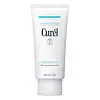What's inside
What's inside
 Key Ingredients
Key Ingredients

No key ingredients
 Benefits
Benefits

 Concerns
Concerns

 Ingredients Side-by-side
Ingredients Side-by-side

Water
Skin ConditioningIsononyl Isononanoate
EmollientGlycerin
HumectantEthylhexyl Palmitate
EmollientCyclohexasiloxane
EmollientDiglycerin
HumectantCoconut Oil Polyglyceryl-6 Esters
EmollientButylene Glycol
HumectantPEG-20 Glyceryl Triisostearate
EmollientAcrylates/C10-30 Alkyl Acrylate Crosspolymer
Emulsion StabilisingPhytosteryl/Octyldodecyl Lauroyl Glutamate
Skin ConditioningPhenoxyethanol
PreservativeSodium Hydroxide
BufferingSodium Stearoyl Glutamate
CleansingTocopheryl Acetate
AntioxidantCyclopentasiloxane
EmollientLeucine
Skin ConditioningSerine
MaskingGlycine
BufferingAmmonium Ferric Pentetate
HumectantAlanine
MaskingArginine
MaskingThreonine
Valine
MaskingHistidine
HumectantCarnosine
Skin ConditioningProline
Skin ConditioningLysine Hcl
Skin ConditioningTocopherol
Antioxidant1,2-Hexanediol
Skin ConditioningHydrogenated Lecithin
EmulsifyingPolyglyceryl-10 Laurate
Skin ConditioningWater, Isononyl Isononanoate, Glycerin, Ethylhexyl Palmitate, Cyclohexasiloxane, Diglycerin, Coconut Oil Polyglyceryl-6 Esters, Butylene Glycol, PEG-20 Glyceryl Triisostearate, Acrylates/C10-30 Alkyl Acrylate Crosspolymer, Phytosteryl/Octyldodecyl Lauroyl Glutamate, Phenoxyethanol, Sodium Hydroxide, Sodium Stearoyl Glutamate, Tocopheryl Acetate, Cyclopentasiloxane, Leucine, Serine, Glycine, Ammonium Ferric Pentetate, Alanine, Arginine, Threonine, Valine, Histidine, Carnosine, Proline, Lysine Hcl, Tocopherol, 1,2-Hexanediol, Hydrogenated Lecithin, Polyglyceryl-10 Laurate
 Reviews
Reviews

Ingredients Explained
These ingredients are found in both products.
Ingredients higher up in an ingredient list are typically present in a larger amount.
Butylene Glycol (or BG) is used within cosmetic products for a few different reasons:
Overall, Butylene Glycol is a safe and well-rounded ingredient that works well with other ingredients.
Though this ingredient works well with most skin types, some people with sensitive skin may experience a reaction such as allergic rashes, closed comedones, or itchiness.
Learn more about Butylene GlycolGlycerin is already naturally found in your skin. It helps moisturize and protect your skin.
A study from 2016 found glycerin to be more effective as a humectant than AHAs and hyaluronic acid.
As a humectant, it helps the skin stay hydrated by pulling moisture to your skin. The low molecular weight of glycerin allows it to pull moisture into the deeper layers of your skin.
Hydrated skin improves your skin barrier; Your skin barrier helps protect against irritants and bacteria.
Glycerin has also been found to have antimicrobial and antiviral properties. Due to these properties, glycerin is often used in wound and burn treatments.
In cosmetics, glycerin is usually derived from plants such as soybean or palm. However, it can also be sourced from animals, such as tallow or animal fat.
This ingredient is organic, colorless, odorless, and non-toxic.
Glycerin is the name for this ingredient in American English. British English uses Glycerol/Glycerine.
Learn more about GlycerinIsononyl Isononanoate is a synthetic skin-conditioner and texture enhancer. It is created from nonanoic acid, a fatty acid found in cocoa and lavender oil.
As an emollient, Isononyl Isononanoate helps keep your skin soft and smooth. This is because emollients create a barrier on the skin to trap moisture in.
Isononyl Isononanoate helps give products a velvet feel and improves spreadability.
Learn more about Isononyl IsononanoateWater. It's the most common cosmetic ingredient of all. You'll usually see it at the top of ingredient lists, meaning that it makes up the largest part of the product.
So why is it so popular? Water most often acts as a solvent - this means that it helps dissolve other ingredients into the formulation.
You'll also recognize water as that liquid we all need to stay alive. If you see this, drink a glass of water. Stay hydrated!
Learn more about Water